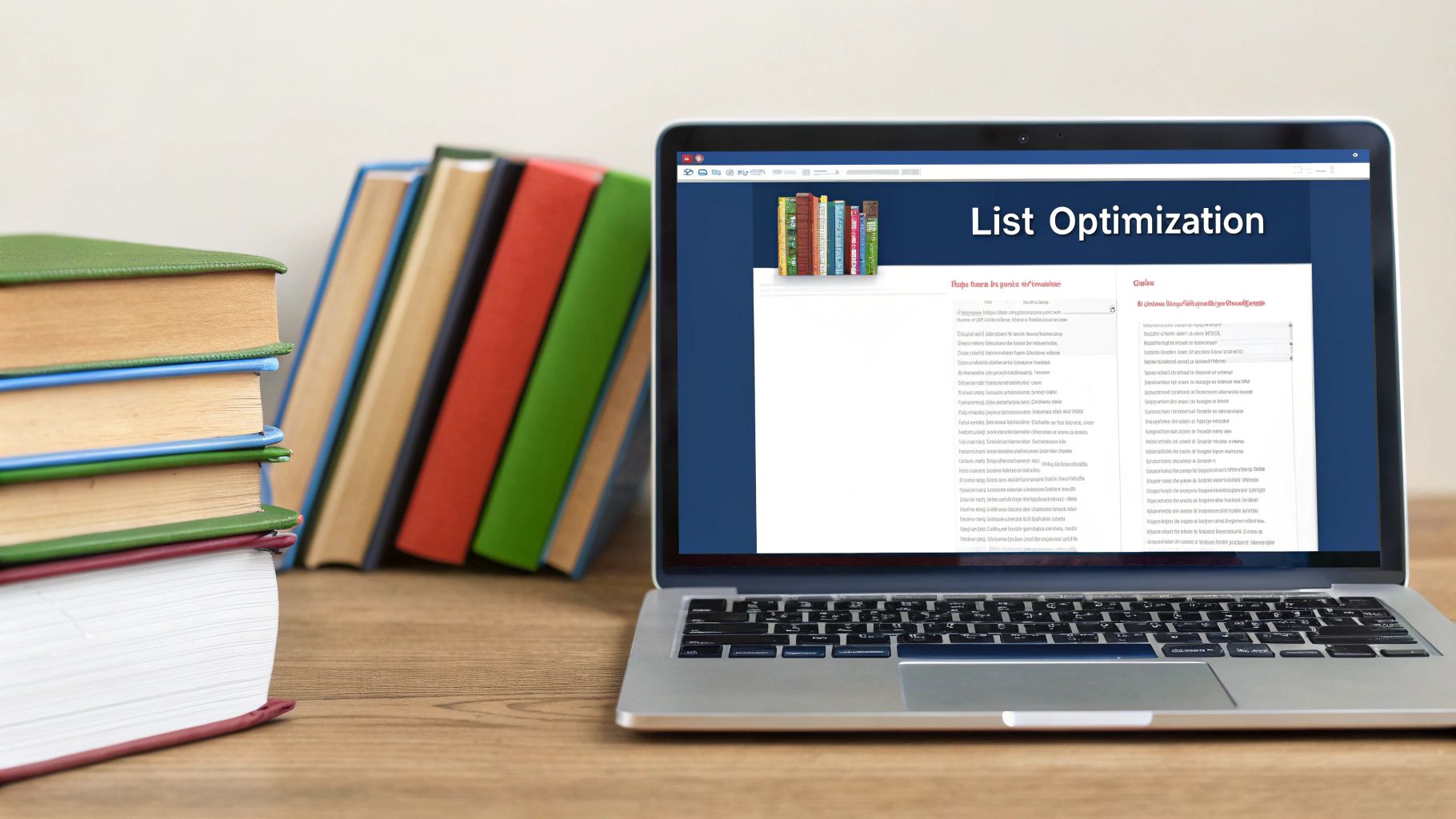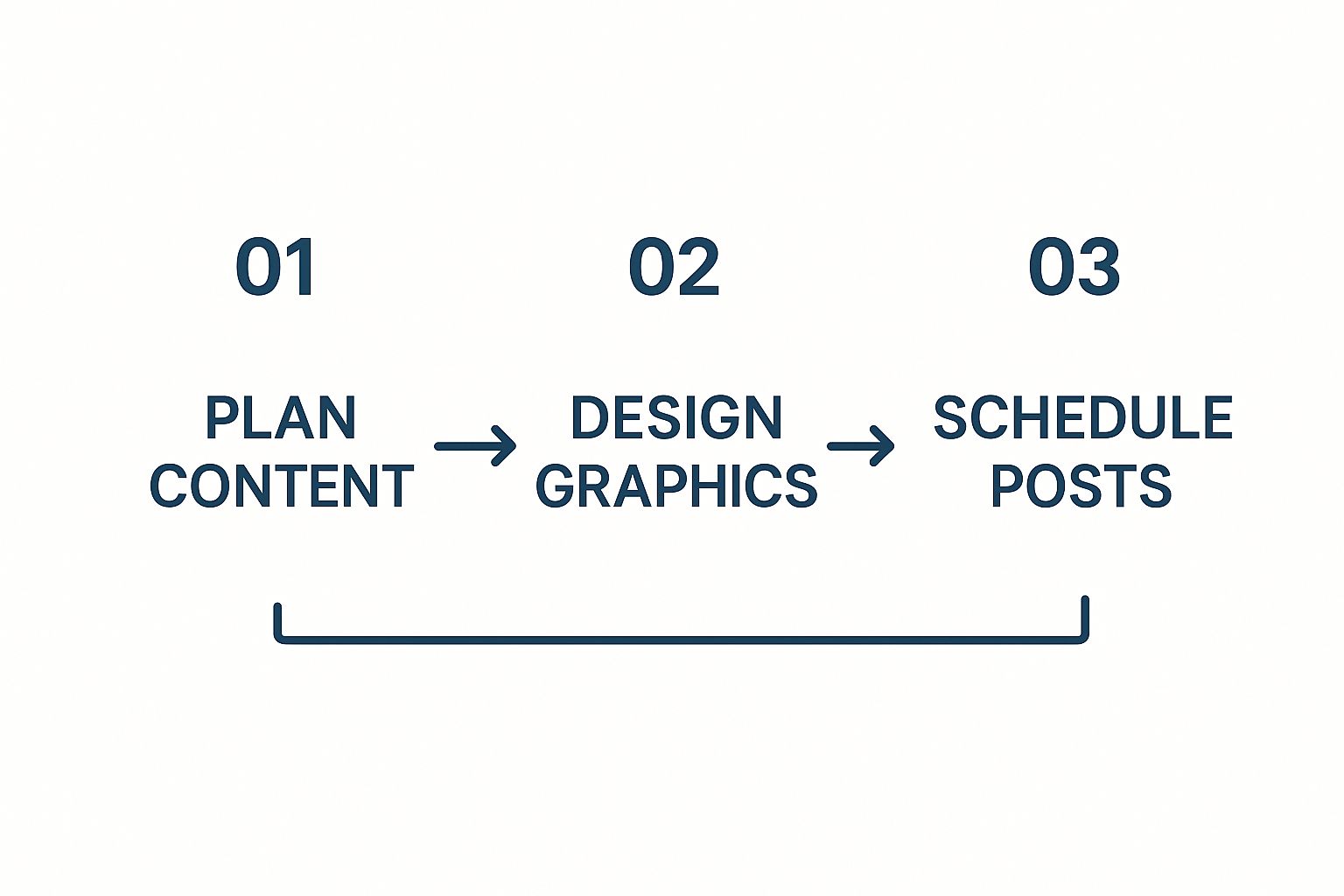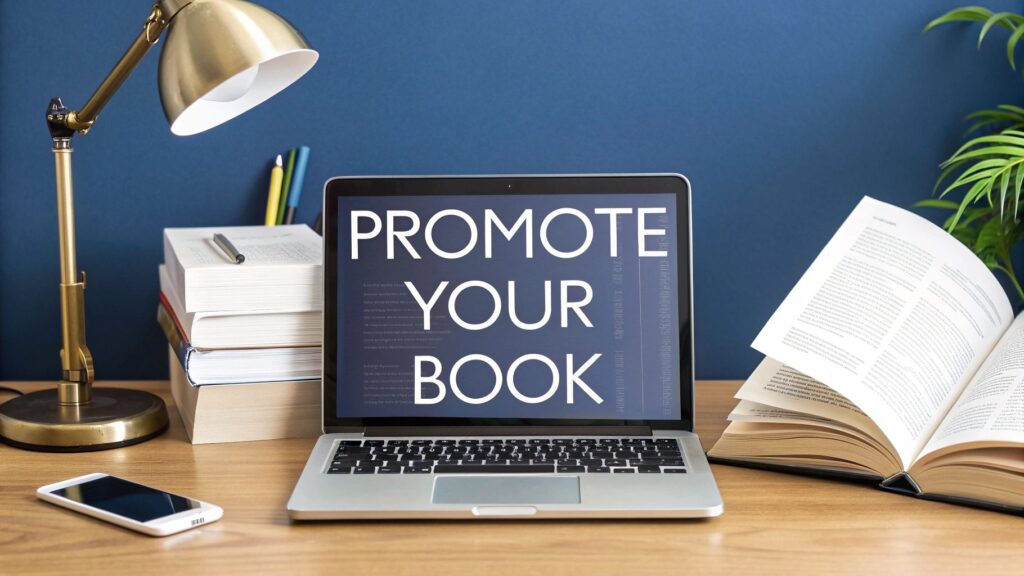Before you even think about spending a single dollar on ads, your book's Amazon page needs to be a well-oiled sales machine. This isn't just a placeholder; it's your digital storefront, and it's your most powerful tool for turning curious browsers into actual readers. Getting this foundation right makes every other promotional effort—from ads to social media posts—infinitely more effective.
Build a Book Page That Actually Sells

Your Amazon book page is the first real handshake you have with a potential reader. Often, it's the only one. A blurry cover, a bland description, or a missing author bio immediately signals amateur hour, and you can bet readers will click away without a second thought.
The goal here is simple: create an immediate sense of professionalism and intrigue. Every single element on that page has a job to do, and that job is to build trust and gently nudge the visitor toward that "Buy Now" button. You’re not just listing facts about your book; you’re telling a story that starts long before someone reads the first chapter.
Craft an Irresistible Book Description
Your book description is your sales pitch. It has one job: hook the reader from the very first line. Forget just summarizing the plot. You need to evoke emotion, spark curiosity, and promise an escape or a solution. Put yourself in your reader's shoes—what kind of questions are they asking? What tropes or themes get their blood pumping?
A killer description almost always contains these elements:
- A gripping hook to start—maybe a provocative question or a bold statement.
- The core conflict, introducing the protagonist and the central problem they're up against (no spoilers!).
- The stakes, making it crystal clear what your character stands to lose or gain.
- A clear call to action at the end, like "Buy now and dive into the mystery."
If you really want to make your description pop, it’s worth brushing up on the fundamentals of mastering web copywriting. These techniques are gold for framing your book in a way that truly connects with your target audience.
Establish Trust with Your Author Bio
Your author bio is more than just a resume; it’s where you build a genuine connection with readers. This is your chance to let your personality shine, establish your expertise, and show why you're a credible voice for this story.
If you’re a fiction author, you might share your passion for the genre or a fun fact that ties into your book. For non-fiction, this is where you highlight your credentials, experience, or the personal journey that led you to write on this topic. Whatever you do, keep it concise, engaging, and professional.
Your Amazon author page is a central hub for your brand. A solid bio, a professional headshot, and links to your website or social media can turn a one-time buyer into a lifelong fan who follows everything you do.
The Power of Metadata and Keywords
What readers don't see is just as important as what they do. Your book’s discoverability rides on its metadata, and nothing is more crucial than your keywords. When readers search on Amazon, they use specific phrases related to genres, tropes, and topics.
Placing these keywords strategically in your title, subtitle, and especially the backend keyword fields is how you tell Amazon's algorithm, "Hey, show my book to these people!" This is non-negotiable for driving organic traffic and making sales in a sea of millions of other books. Getting your keywords right is what separates the books that get found from the ones that fade into obscurity.
Essential Book Page Optimization Checklist
Before you launch a single ad, run through this checklist. Think of it as your pre-flight inspection to make sure every part of your book page is working hard to convert visitors into readers. Each element is a piece of the puzzle.
| Element | Key Action | Why It Matters |
|---|---|---|
| Cover Design | Ensure it's professional, genre-appropriate, and legible as a tiny thumbnail. | The cover is your book's first impression and your single biggest marketing asset. |
| Book Description | Write a compelling, hook-driven summary with strategic formatting (bolding, bullets). | This is your primary sales copy. It's what convinces someone to click "buy." |
| Author Bio | Create a professional bio that builds trust and forges a connection with readers. | It establishes your authority and encourages readers to follow your entire body of work. |
| Keywords | Fill all 7 backend keyword slots with relevant, well-researched phrases. | This is how the Amazon algorithm shows your book to the right audience in search results. |
| Categories | Choose 2 niche, relevant categories where your book can realistically compete for rank. | Proper categorization helps readers find you and is the path to that coveted bestseller tag. |
Taking the time to nail these elements sets a powerful foundation, ensuring that when you do start driving traffic to your page, it's ready to turn those clicks into sales.
Getting Your Book Discovered with Keywords and Categories
https://www.youtube.com/embed/-Bg2dBl1g7s
Okay, so you’ve polished your book page until it shines. But what good is a great page if readers can’t find it? On a marketplace as massive as Amazon, discoverability isn't about luck. It's about feeding the Amazon algorithm exactly what it needs to place your book in front of the right people.
This is where your keywords and categories come in, and honestly, they're your most powerful, non-paid promotional tools.
Think of keywords as the secret language you share with your ideal reader. I'm not talking about broad, single words like "mystery" or "fantasy." Real discoverability comes from understanding the specific, longer phrases people are actually typing into that search bar. These long-tail keywords are pure gold because they reveal exactly what a reader wants.
For instance, someone isn't just looking for "romance." They're searching for "enemies to lovers office romance," "second chance romance over 40," or maybe "billionaire single dad clean romance." Each phrase points to a very specific, motivated audience. Your job is to find the ones that are a perfect fit for your book.
Digging for Keyword Gold
The first step is to get out of your author brain and into your reader's head. Forget how you would describe your book. How would a fan of your genre search for it?
Start by brainstorming the core DNA of your story:
- Tropes and Themes: Does your book use popular hooks like "found family," "magic academy," or "grumpy sunshine"? List them.
- Character Archetypes: Who's your hero? A "female detective with a past"? A "morally gray anti-hero"?
- Setting and Time Period: Where and when does it all happen? "post-apocalyptic survival"? "Regency England mystery"?
- Comparable Authors: Who do your fans also read? People constantly search for "books like [Author Name]."
Once you have a starting list, it's time to expand it. Your best free tool is Amazon's own search bar. Start typing your ideas and watch the autofill suggestions. Those aren't guesses; they're the exact phrases people are searching for right now.
Pro Tip: Always use an incognito or private browser window for this research. It stops your own search history from skewing the results, giving you a clean look at what real readers are doing.
If you want to go deeper, a tool like Publisher Rocket is a game-changer. It helps you analyze how competitive certain keywords are and how many people are searching for them. This lets you pinpoint keywords with high reader interest but lower competition—the sweet spot where your book can really get noticed.
Conquering Amazon Categories
Categories are the virtual shelves where your book sits. Choosing them wisely is absolutely crucial for hitting those coveted Amazon Bestseller lists. KDP only lets you pick two or three categories from the dashboard, but you can actually get your book into as many as 10.
The secret is finding niche, less-crowded categories where your book has a realistic shot at ranking high. Becoming a #1 Bestseller in "Science Fiction & Fantasy > Fantasy > Myths & Legends > Greek & Roman" is a whole lot easier (and still looks great) than trying to duke it out in the main "Fantasy" category.
To find these hidden gems, go look at the books that are similar to yours. Click through their product pages and see what specific category paths they rank in. Look for those deep, relevant sub-niches where a relatively small number of sales can shoot you straight to the top. After you've found your targets, just contact Amazon support through your KDP dashboard and request to be added.
Combining a sharp keyword strategy with smart category choices is the foundation of a successful book launch. For more ways to build on this, check out our giant list of book promotion ideas. You can also explore more advanced strategies for traffic generation using keywords to make sure your book finds its perfect audience.
Price Your Book for Profit and Momentum

Let's talk about one of the most powerful marketing tools you have: your book's price. It’s so much more than just a number. It sends a direct signal to readers about your book's value and where it fits in the market. Get it right, and you can spark some serious sales momentum. Get it wrong, and a launch can fizzle out before it even starts.
There's no single "correct" price, as different strategies serve different goals. I've seen countless authors launch a new book at a low price, like $0.99 or $2.99, just to get the ball rolling. This encourages those crucial impulse buys, racks up sales, and helps juice your sales rank. Suddenly, you're popping up in Amazon's "also-boughts." On the flip side, especially with non-fiction, a higher price can signal premium, expert content that readers are often willing to pay for.
Understanding Amazon Royalty Structures
Before you set a price, you absolutely have to know how you'll get paid. Your pricing decision directly impacts your royalties, and Amazon’s rules are non-negotiable.
For eBooks, the magic window is between $2.99 and $9.99. Price your book in that range, and you’re eligible for a 70% royalty rate. Go below $2.99 or above $9.99, and that rate gets slashed to just 35%. It's a clear incentive to stay within that band for max profit per sale, but sometimes a temporary dip into the 35% zone is a strategic move to hook readers for a series.
The world of paperbacks has its own complexities. For instance, Amazon recently tweaked its royalty rate for paperbacks priced under $9.99, dropping it from 60% to 50%. This was a huge blow to authors of shorter works or low-content books. A simple notebook priced at $5.99 that used to net about $0.75 suddenly saw its profit dive to around $0.16 per sale. It’s a stark reminder to always stay on top of platform changes.
Strategic Pricing for Your Book Launch
So, what's the game plan for your launch? It really boils down to balancing immediate visibility with long-term profit. You'll hear authors swear by two main approaches.
Pricing Strategy Comparison
| Strategy | Pros | Cons | Best For |
|---|---|---|---|
| Launch Low (e.g., $0.99) | – Drives a flood of initial sales & reviews – Shoots your Amazon Sales Rank up quickly – Easy "yes" for readers new to your work |
– Tiny profit per book – Can make the book seem "cheap" – Often attracts bargain hunters, not die-hard fans |
The first book in a series, authors trying to build an audience, or a big coordinated promotion. |
| Launch at Full Price (e.g., $4.99+) | – Maximizes profit from your core fans – Projects confidence and quality – Sets a strong price anchor from day one |
– A much slower start on sales – A tougher sell for an unknown author |
Established authors with a fan base, meaty standalone non-fiction, or books on premium niche topics. |
A popular and devastatingly effective tactic is to launch low for the first week to climb the charts, then raise the price to its permanent home. This gives you the best of both worlds: a quick sales burst to get Amazon's algorithm on your side, followed by sustainable, long-term profit.
Using KDP Select Promotions to Your Advantage
If you've enrolled your book in KDP Select, you've unlocked some powerful price-based promotional tools. These are your secret weapons for creating a burst of activity and are a cornerstone of many successful marketing plans.
- Kindle Countdown Deals: This is a fantastic way to run a limited-time discount. You can set up a deal that lasts for a few days, with the price ticking back up to its original list price over time. It creates a sense of urgency that buyers find hard to resist and is perfect for breathing life back into an older title.
- Free Book Promotions: For up to five days each KDP Select term, you can make your book completely free. You won't earn royalties on the downloads, but you can gain thousands of new readers. The goal here is exposure—getting your story into the hands of people who might then buy your other books or leave that all-important review.
Pairing these KDP tools with a smart pricing strategy is a fundamental part of promoting your book on Amazon. For a deeper look into building out your promotional calendar, check out our guide on developing effective book marketing strategies.
Run Amazon Ad Campaigns That Actually Work
Let's be honest: diving into Amazon Advertising without a plan is one of the fastest ways to burn through your marketing budget. But when you know what you’re doing, a targeted ad campaign becomes a powerful engine for driving visibility and sales. The secret isn't outspending everyone else; it's about outsmarting them with a focused, data-driven approach.
The platform can feel a bit intimidating at first, but for most authors, it boils down to two main ad types: Sponsored Products and Sponsored Brands. Knowing when and how to use each one is crucial for building a campaign that actually turns a profit.
This visual breaks down a simple workflow for getting your promotional content ready.

Think of this as your roadmap. Planning your content, designing eye-catching visuals, and scheduling your posts create a smooth system for all your marketing, including your ads.
Choose the Right Campaign for Your Goal
Sponsored Products are the bread and butter of Amazon ads. These are the individual book listings you see popping up in search results and on the product pages of other books. They're perfect for getting your book in front of specific readers with surgical precision, based on the exact keywords they're searching for or the books they're browsing.
- When to use them: Great for a new book launch, pushing a specific title in a series, or even poaching readers from a direct competitor.
- Real-world scenario: Imagine you've written a gritty sci-fi novel. You can set up a Sponsored Product ad to target readers searching for "dystopian military sci-fi." You can also target the product pages of authors like Pierce Brown or John Scalzi. Your book appears right in their path, exactly when they're looking for their next read.
Sponsored Brands are more about building your overall author brand. These are the banner ads you see at the top of search results, usually featuring your author logo, a catchy headline, and up to three of your books.
- When to use them: Ideal when you have a series to promote, want to cement your name as a go-to author in your genre, or are running a big sale across multiple titles.
- Real-world scenario: Let's say you have a trilogy of fantasy romance novels. A Sponsored Brand ad with a headline like "Fall for the Fae King's Curse" showcasing all three books can be incredibly effective. When a reader clicks, you can send them straight to a custom Amazon Store page that features your entire backlist.
If you want to go deeper into the mechanics of paid ads, this guide covers everything you need to know about Amazon Ads. It’s a solid resource for getting into the nitty-gritty.
Launching Your First Campaign
Getting started doesn't have to be a headache. My advice? Start small. Focus on just one book and stick with a Sponsored Products campaign to begin with—they are much simpler to manage.
Setting a Realistic Budget
You don’t need a huge budget to see what works. A daily budget of just $5 to $10 is plenty to start gathering data. This lets you test the waters without taking a big financial hit. The goal isn't to spend a lot of money; it's to spend it smartly.
Selecting Your Keywords
Your keyword strategy is the absolute heart of your campaign. This is where all that research you did on discoverability really pays off. You want to focus on long-tail keywords—those specific, multi-word phrases that signal a reader knows exactly what they want.
- Broad Match: This targets a wide range of searches. It's risky for beginners and can burn through your budget fast on clicks that aren't relevant.
- Phrase Match: Your ad shows up when someone searches for your exact phrase, even if they add words before or after it. This is a great middle-ground option.
- Exact Match: The ad only appears for that precise keyword. This gives you the most control and usually delivers the best conversion rate.
I always recommend starting with a tight list of 20-30 highly relevant Phrase and Exact Match keywords. This gives you control from day one and helps you see which search terms are actually making you money.
Understanding Your Ad Reports and ACoS
Flipping the "on" switch for your ad is just the beginning. The real work starts when you dig into the data. The single most important metric you need to live and breathe is your Advertising Cost of Sale (ACoS).
ACoS tells you what percentage of your sales revenue you spent on advertising to get those sales. The formula is straightforward: (Total Ad Spend ÷ Total Sales) x 100.
For example, if you spent $20 on ads and made $50 in book sales, your ACoS is 40%. A "good" ACoS is entirely dependent on your royalty rate. If you earn a 70% royalty on a sale, a 40% ACoS is fantastic—you're profitable. But if your royalty is only 35%, that same ACoS means you're losing money on every ad-driven sale.
Check your campaign dashboard every few days. Look for keywords that get a lot of clicks but zero sales—these are budget vampires, so pause them immediately. On the flip side, find the keywords with a low ACoS and consider nudging their bids up slightly. This constant process of tweaking and optimizing is how you transform a break-even campaign into a profitable sales machine for your books.
Generate Credibility with Authentic Reader Reviews

Let's be honest: reviews are the lifeblood of your book on Amazon. They are today’s word-of-mouth marketing, the most powerful social proof you can get. When a potential reader lands on your book page, a healthy number of reviews tells them your book is worth their time and money.
Without reviews, even the most captivating story or groundbreaking nonfiction can feel like a ghost town. Your main goal, especially right after launch, is to get a baseline of honest reviews as quickly as you can. This initial momentum makes all your other marketing, like running ads, so much more effective. Think about it—which book are you more likely to buy? The one with zero reviews, or the one with fifteen?
Building Your Advance Reader Team
This is where an Advance Reader Copy (ARC) team comes in. An ARC team is simply a group of dedicated readers who get a free, early copy of your book. In return, they agree to leave an honest review on or around launch day. It's one of the best, most ethical ways to kickstart your review count.
Your ARC team doesn't need to be huge. Even a small, enthusiastic group of 20-30 people can make a massive difference.
So, where do you find these readers? Start close to home, with the audience you already have.
- Your Email List: These are your warmest leads. Your subscribers already like your work and are the most likely to be thrilled to help you out.
- Social Media Followers: Post a call for volunteers on your social media channels. Frame it as an exclusive opportunity to join your "launch team."
- A Dedicated Landing Page: Create a simple sign-up page on your author website specifically for your ARC team and point interested people there.
Using Platforms to Find Reviewers
What if you're building your audience from scratch? No problem. There are several platforms designed specifically to connect authors with eager reviewers. Services like Booksprout and StoryOrigin let you post your ARC and find readers who are actively looking for new books in your genre.
These platforms are a lifesaver. They often handle the logistics of delivering the book file and sending out reminders to post reviews, which frees you up from a ton of administrative headaches. They are an incredible resource for grabbing those critical early reviews that signal to the Amazon algorithm that your book is picking up steam.
The scale of Amazon’s marketplace is just staggering. The platform accounts for roughly 50% of all print books sold in the U.S., which adds up to over 300 million books and $28 billion in global revenue each year. These numbers show why smart promotion, especially generating reviews, is absolutely essential to stand out from the crowd.
The Right Way to Ask for Reviews
When asking for reviews, you need to be careful to stay within Amazon's rules. Never, ever offer payment or any other compensation for a review. That's a fast track to getting your book and account flagged.
What you can do is make the process as simple as possible.
A great place to start is in the back of your book. Add a polite, humble request for a review after the story ends. Something as simple as, "Thank you for reading! If you enjoyed this book, please consider leaving a short, honest review on Amazon" works perfectly. For a deeper dive into promotional strategies, you can also check out our guide on how to promote your book.
Handling Negative Reviews Gracefully
It's going to happen. Sooner or later, you'll get a negative review. It’s an unavoidable part of being an author, and it's okay. The key is how you react.
The golden rule: Never, ever engage with a negative reviewer. Replying almost always makes you look unprofessional and just pours fuel on the fire.
Instead, try to see the bright side. A book page with nothing but glowing, five-star reviews can actually look a little suspicious to savvy shoppers. A mix of opinions shows that real, diverse readers are engaging with your work. If there's a nugget of constructive feedback in the criticism, take it on board for your next book. Otherwise, just let it go and focus on writing your next one.
Your Top Amazon Book Promotion Questions, Answered
Let's be honest: figuring out how to promote your book on Amazon can feel like a full-time job. There's a ton of conflicting advice out there, and Amazon's rules aren't always crystal clear. I've been there, and I’ve helped countless authors get through it.
This section cuts through the noise. I’ll give you direct, practical answers to the questions I hear most often, based on real-world experience. Think of it as a cheat sheet for making smarter marketing moves.
How Many Reviews Should My Book Have Before I Run Ads?
This is the big one, isn't it? While Amazon won't give you a magic number, the consensus among authors who are successfully running ads is pretty strong: aim for at least 10-15 genuine reviews before you start spending serious cash.
Why? It all comes down to trust. Imagine a reader clicks your ad. They're interested. But when they land on your book page and see zero reviews, or maybe just one from your cousin, that interest evaporates. They hesitate. Starting ads with no social proof often leads to a sky-high Advertising Cost of Sale (ACoS) because your conversion rate will be in the basement.
Those first 10-15 reviews are your foundation. They tell new shoppers, "Hey, other people bought this book and liked it. It's a safe bet." That little bit of confidence is often all it takes to turn a click into a sale.
Should I Enroll My Book in KDP Select or Go Wide?
Ah, the great debate. The truth is, there's no single right answer—it completely depends on your goals for your book and your author career. Enrolling in KDP Select means giving Amazon the exclusive digital rights to your ebook for renewable 90-day terms.
Here’s how I break it down for authors trying to decide:
-
You should probably use KDP Select if: Your launch plan leans heavily on Amazon-specific tools. We're talking about Kindle Unlimited (getting paid for pages read), Kindle Countdown Deals, and Free Book Promotions. For new authors, or for the first book in a series, this is a fantastic way to build an initial audience and get that first wave of readers hooked.
-
You should "Go Wide" (don't enroll) if: Your goal is to build a brand across multiple storefronts like Apple Books, Kobo, and Barnes & Noble. This approach diversifies your income and builds a more resilient, long-term author business that isn't dependent on a single retailer.
If you're asking for my personal take, I often advise new authors to try KDP Select for their first 90 days. It gives you access to some powerful promotional levers that are perfect for generating that initial sales velocity and getting those crucial early reviews. You can always opt out after the term is up and go wide once you have some momentum.
What’s a Realistic Daily Budget for a New Amazon Ad Campaign?
Diving into Amazon Ads can feel a bit like gambling if you're not careful. It's tempting to throw a lot of money at it, hoping for a quick win. Don't.
For a brand-new campaign, start small. A daily budget of $5 to $10 is the perfect place to begin.
The goal with this small budget isn't to sell thousands of books overnight. The real goal is much more valuable: collecting data. You are paying for information. You're learning which of your keywords and targeting ideas actually work, all without risking your shirt.
Let it run for a week or two. You'll quickly see which keywords are getting clicks and, more importantly, which ones are actually leading to sales. Once you've identified your winners—the keywords with a profitable ACoS—that's when you can start confidently increasing your daily budget. This methodical, data-driven approach is how you build a profitable ad strategy that lasts.
Ready to turn your manuscript into a global success story? At BarkerBooks, we provide end-to-end publishing support, from professional editing and cover design to strategic marketing and worldwide distribution. Let us handle the complexities so you can focus on what you do best—writing. Discover how we’ve helped over 7,500 authors achieve their publishing dreams.
